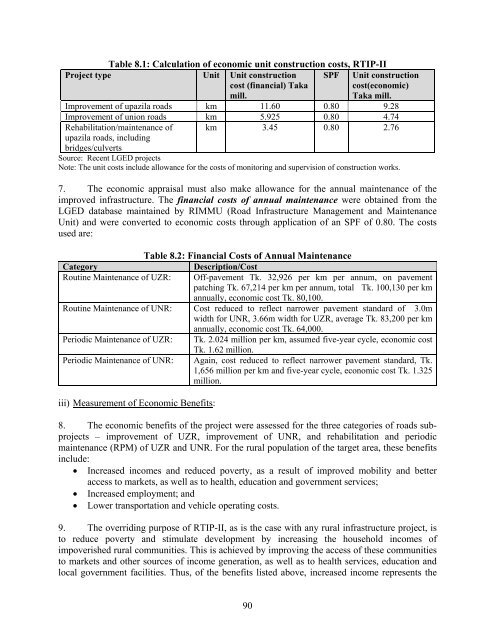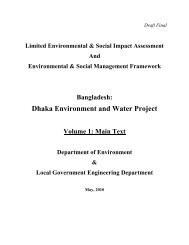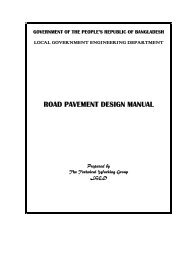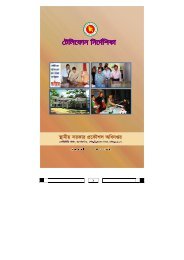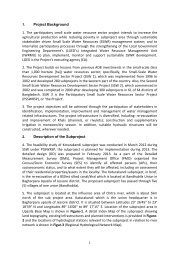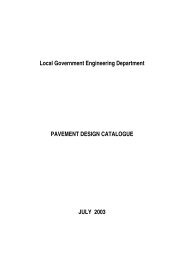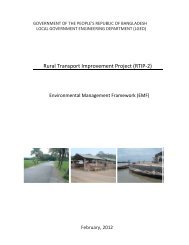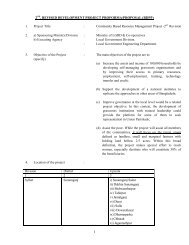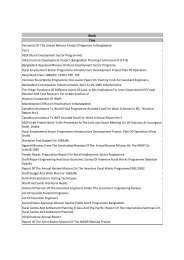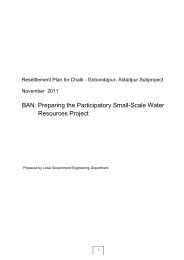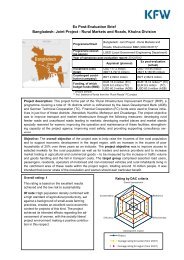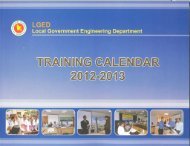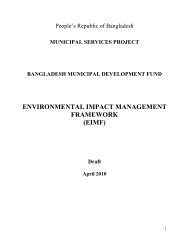PAD - LGED
PAD - LGED
PAD - LGED
You also want an ePaper? Increase the reach of your titles
YUMPU automatically turns print PDFs into web optimized ePapers that Google loves.
Table 8.1: Calculation of economic unit construction costs, RTIP-II<br />
Project type Unit Unit construction<br />
cost (financial) Taka<br />
mill.<br />
SPF Unit construction<br />
cost(economic)<br />
Taka mill.<br />
Improvement of upazila roads km 11.60 0.80 9.28<br />
Improvement of union roads km 5.925 0.80 4.74<br />
Rehabilitation/maintenance of km 3.45 0.80 2.76<br />
upazila roads, including<br />
bridges/culverts<br />
Source: Recent <strong>LGED</strong> projects<br />
Note: The unit costs include allowance for the costs of monitoring and supervision of construction works.<br />
7. The economic appraisal must also make allowance for the annual maintenance of the<br />
improved infrastructure. The financial costs of annual maintenance were obtained from the<br />
<strong>LGED</strong> database maintained by RIMMU (Road Infrastructure Management and Maintenance<br />
Unit) and were converted to economic costs through application of an SPF of 0.80. The costs<br />
used are:<br />
Table 8.2: Financial Costs of Annual Maintenance<br />
Category<br />
Description/Cost<br />
Routine Maintenance of UZR:<br />
Off-pavement Tk. 32,926 per km per annum, on pavement<br />
patching Tk. 67,214 per km per annum, total Tk. 100,130 per km<br />
annually, economic cost Tk. 80,100.<br />
Routine Maintenance of UNR: Cost reduced to reflect narrower pavement standard of 3.0m<br />
width for UNR, 3.66m width for UZR, average Tk. 83,200 per km<br />
annually, economic cost Tk. 64,000.<br />
Periodic Maintenance of UZR:<br />
Periodic Maintenance of UNR:<br />
iii) Measurement of Economic Benefits:<br />
Tk. 2.024 million per km, assumed five-year cycle, economic cost<br />
Tk. 1.62 million.<br />
Again, cost reduced to reflect narrower pavement standard, Tk.<br />
1,656 million per km and five-year cycle, economic cost Tk. 1.325<br />
million.<br />
8. The economic benefits of the project were assessed for the three categories of roads subprojects<br />
– improvement of UZR, improvement of UNR, and rehabilitation and periodic<br />
maintenance (RPM) of UZR and UNR. For the rural population of the target area, these benefits<br />
include:<br />
• Increased incomes and reduced poverty, as a result of improved mobility and better<br />
access to markets, as well as to health, education and government services;<br />
• Increased employment; and<br />
• Lower transportation and vehicle operating costs.<br />
9. The overriding purpose of RTIP-II, as is the case with any rural infrastructure project, is<br />
to reduce poverty and stimulate development by increasing the household incomes of<br />
impoverished rural communities. This is achieved by improving the access of these communities<br />
to markets and other sources of income generation, as well as to health services, education and<br />
local government facilities. Thus, of the benefits listed above, increased income represents the<br />
90


